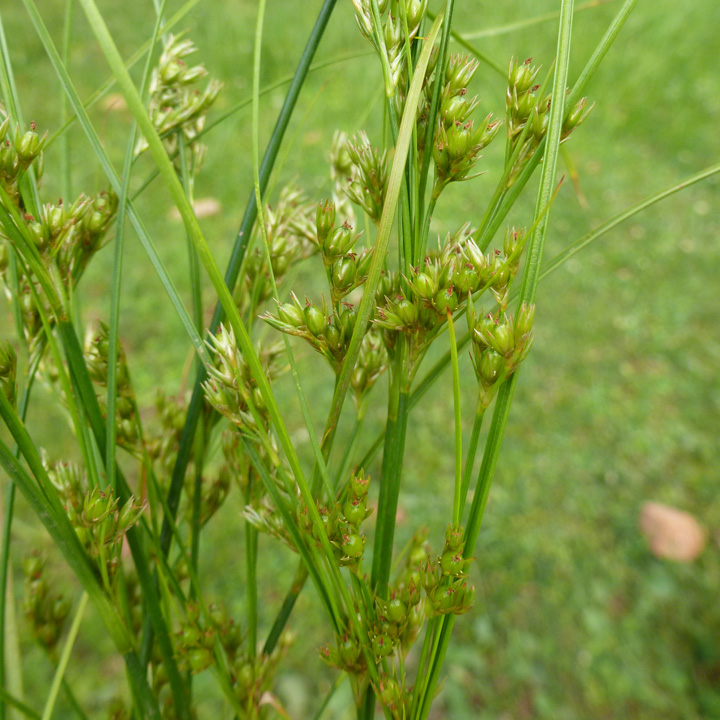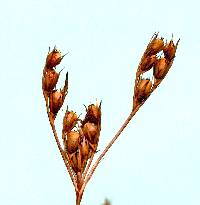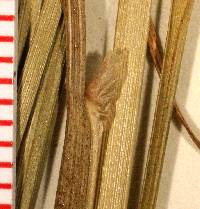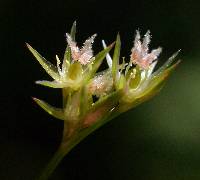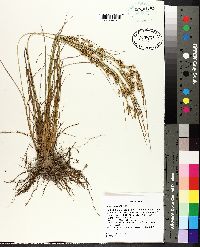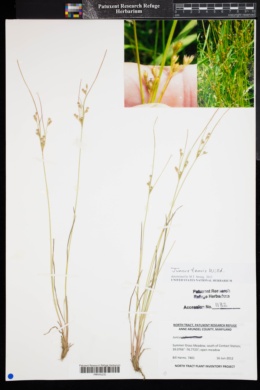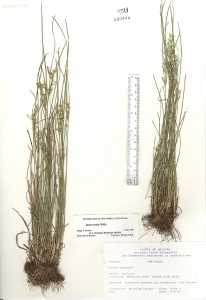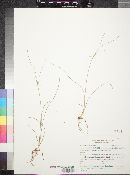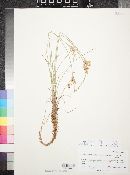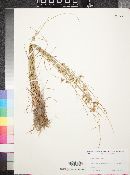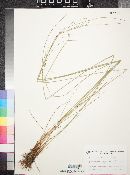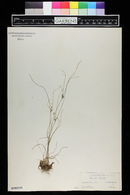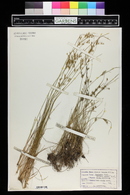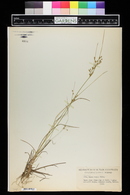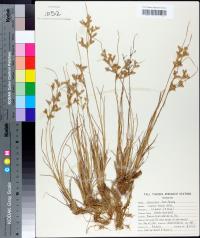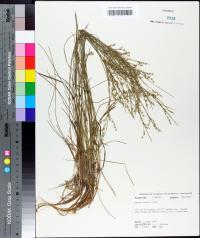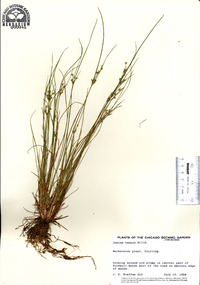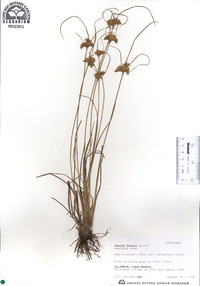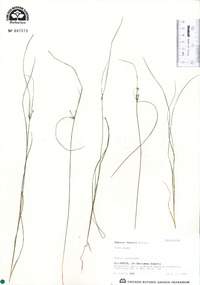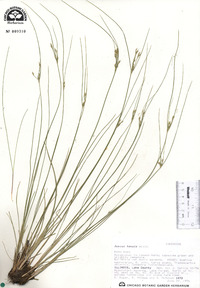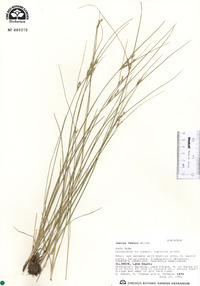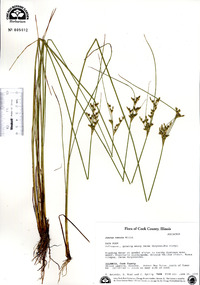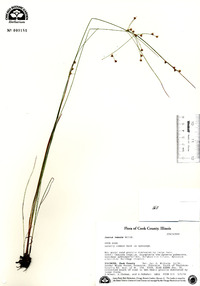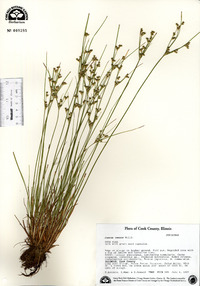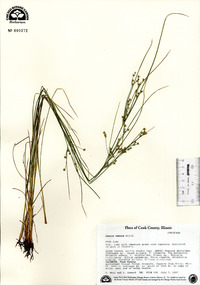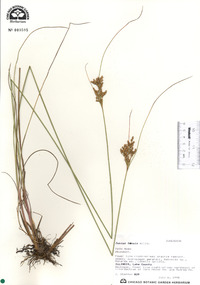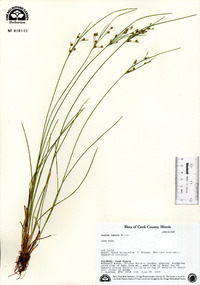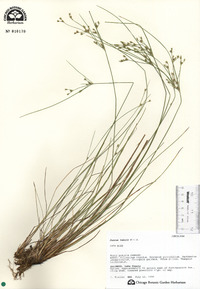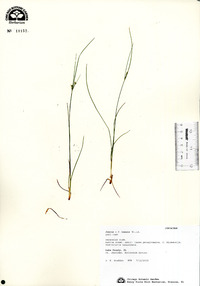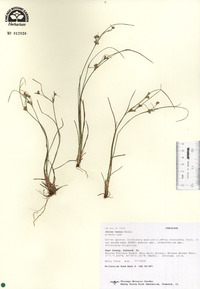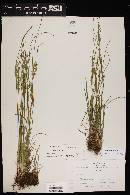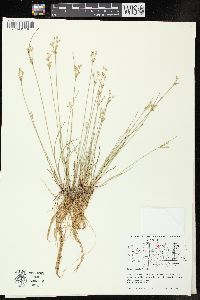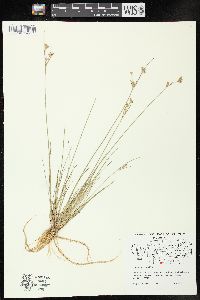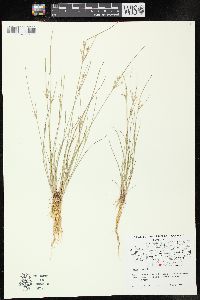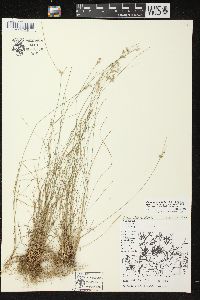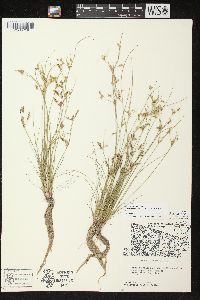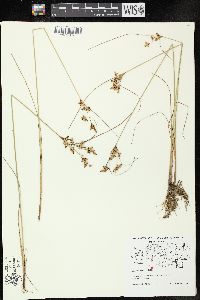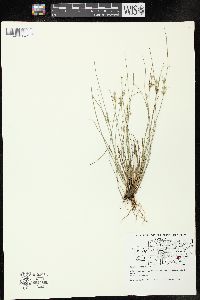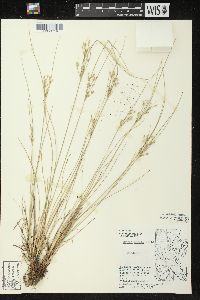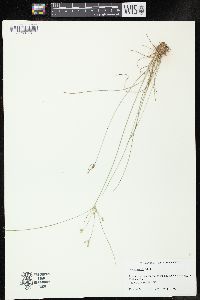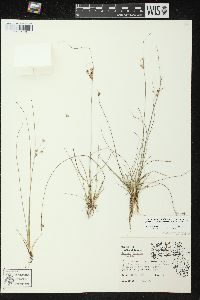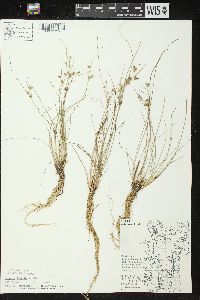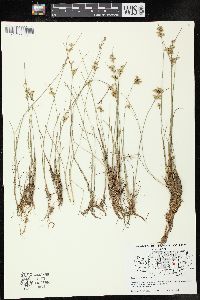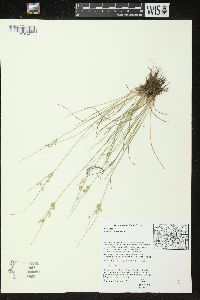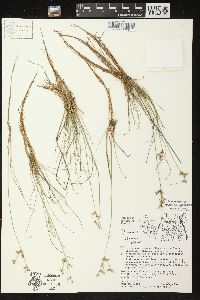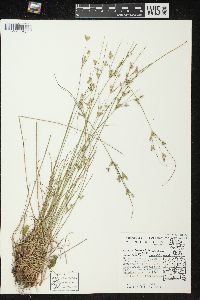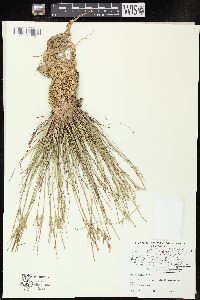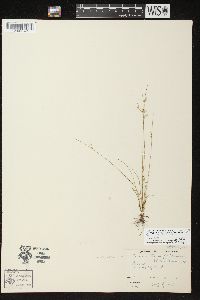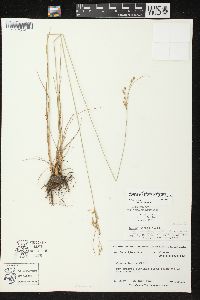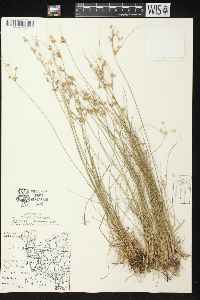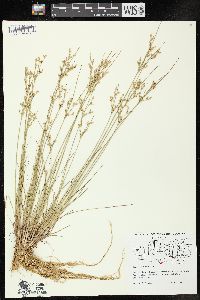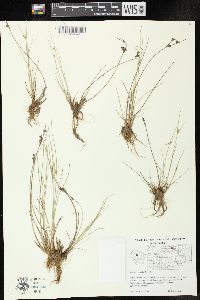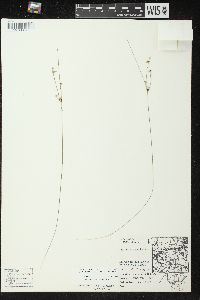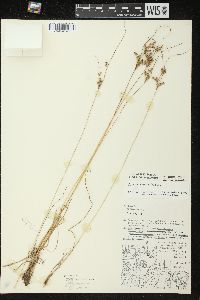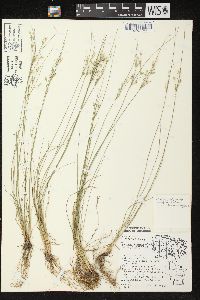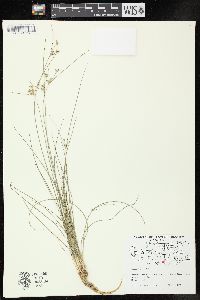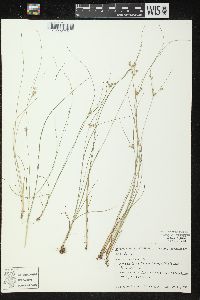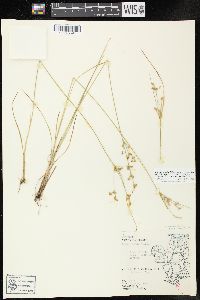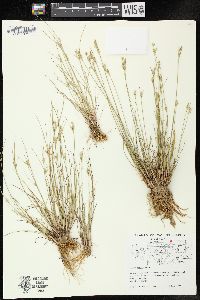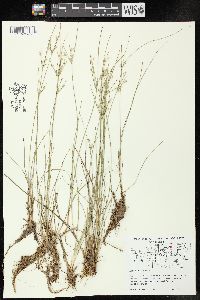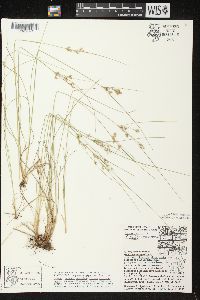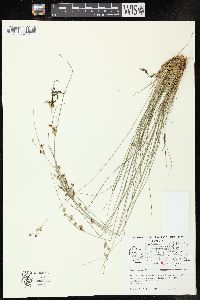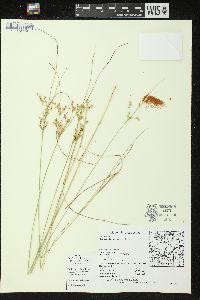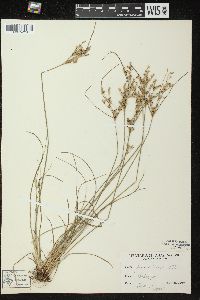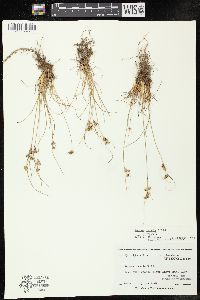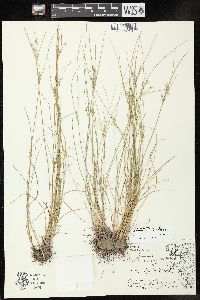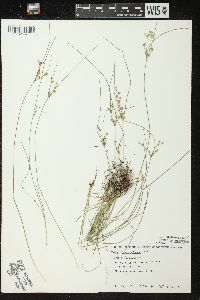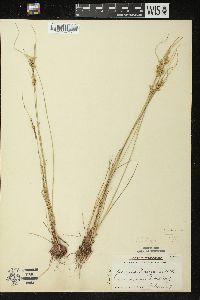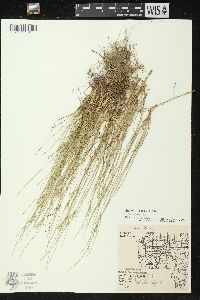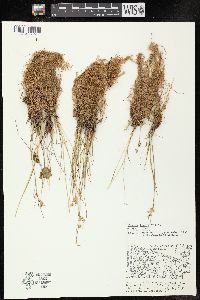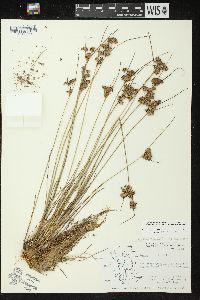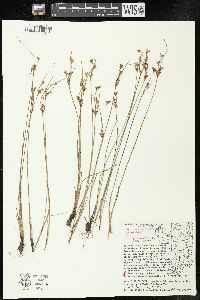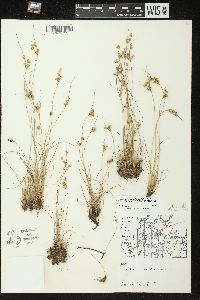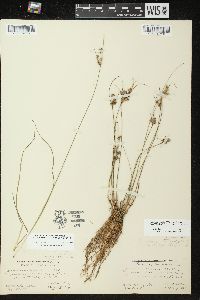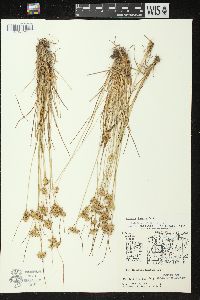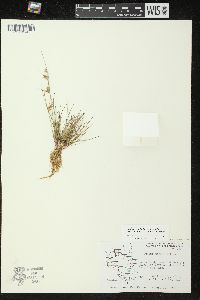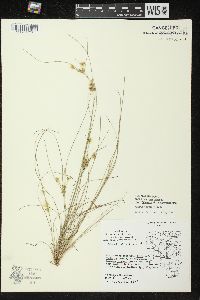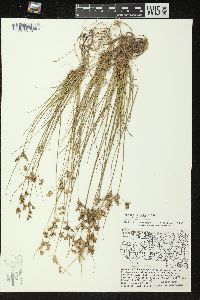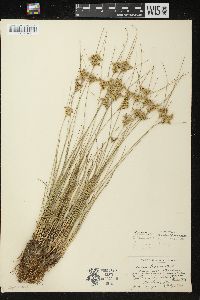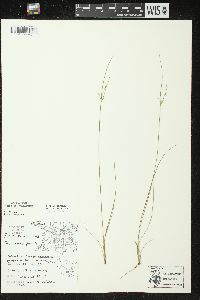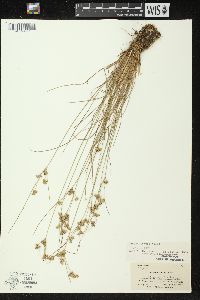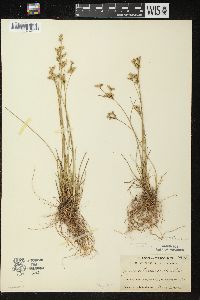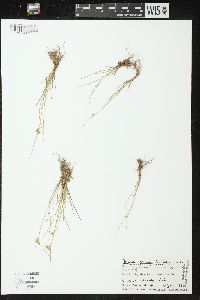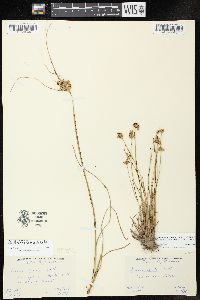Juncus tenuis
|
|
|
|
Family: Juncaceae
Lesser Poverty Rush, more...field rush, path rush, poverty rush, slender rush, slender yard rush, wiregrass
[Juncus bicornis Michx., moreJuncus macer S.F. A. Gray, Juncus macer f. williamsii (Fernald) F. J. Herm., Juncus tenuis f. williamsii (Fernald) F. J. Herm., Juncus tenuis var. multicornis E. Mey., Juncus tenuis var. williamsii Fern., Juncus vacillans Steud.] |
Perennial grasslike forb 15 - 50 cm tall Leaves: one to three, basal, 3 - 12 cm long, 0.5 - 1 mm wide, linear, grasslike, flattened in cross section, and lacking crosswise partitions inside (non-septate). The leaves also have a fragile, easily broken, transparent, membranous, basal, 2 - 5 mm long, pointed-tipped, ear-like appendage (auricle) at the top of the clear-edged leaf sheath. Inflorescence: a terminal, somewhat loose, 1 - 5 cm long, multi-branched structure with five to forty, single, very short-stalked, radially symmetric, small flowers borne congested at the ends of short (under 5 mm) secondary branches. The entire branched inflorescence is subtended by a large (usually longer than full inflorescence) bract, and the individual short-stalked flowers have two small bracts (bracteoles) positioned directly below the tepals. Stamens: six, with 0.5 - 0.9 mm long filaments, and 0.1 - 0.2 mm long anthers. Pistil: with one superior ovary, a 0.1 - 0.2 mm long style, and three stigmas. Fruit: single-chambered, tan or light brown, 3.3 - 4.7 mm tall (about same length as tepals), 1.1 - 1.7 mm wide, ellipsoid, very short-stalked capsules borne on congested branches. Each capsule is surrounded by the erect, remnant tepals. Stems: tufted, erect, smooth, round in cross section, and arising from densely branched rhizomes. Seeds: many, tan, 0.5 - 0.7 mm long, ellipsoid to crescent-shaped with short-pointed or abruptly narrowed tips, but without distinct narrowed tails at the ends. Tepals: six in two whorls of three, greenish, 3.3 - 4.4 mm long (all about same length), lance-shaped with pointed tips. Similar species: Juncus tenuis is most similar to J. anthelatus, except that species is typically larger (often over 70 cm tall), and it has widely spaced, shorter capsules (2 - 3.2 mm) on more spreading inflorescence branches. Also very similar are J. dudleyi and J. interior, but neither of those species have long, pointed, fragile ear-like appendages (auricles) at the summit of the leaf sheaths, rather they are well under 1 mm long and hard or even leathery. Other species such as J. vaseyi and J. greenei differ by having leaves that are almost round in cross section. The non-native J. compressus should be obviously differentiated by its much shorter auricles (only up to 0.5 mm), blunt-tipped tepals, and darker colored capsules. Flowering: late May to September Habitat and ecology: Common, especially in compacted soils such as in shaded paths, picnic areas, and trails. Occurence in the Chicago region: native Notes: The long, pointed, fragile, ear-like appendages (auricles) at the top of the leaf sheaths are a key feature of this species, unfortunately often the very tip can be broken off on specimens. This species has been shown to hybridize with several species, including J. anthelatus, J. interior, and J. vaseyi. Author: The Field Museum Stems ±cespitose, 1-8 dm; lvs basal, 1-3 dm, a third to half the height of the stems, flat and 1-1.5 mm wide, or becoming involute, varying to subterete and merely narrowly channeled on the upper side; sheaths scarious-margined, auriculate; invol lf 1-10 cm, often surpassing the infl, but not appearing as a continuation of the stem; infl loosely branched, not secund, the fls prophyllate; tep lance-subulate, the sep 3-5.5 mm, the pet 2.8-5 mm; anthers 6, shorter than the filaments; fr oblong- ovoid or slightly obovoid, obtuse to truncate, 2.6-4.2 mm, shorter than the sep, only imperfectly trilocular, the partitions not meeting in the center; seeds 0.3-0.5 mm, merely apiculate, mucilaginous when wetted; 2n=40, 42, 80, 84. Dry or moist (often compacted) soil, abundant along forest paths; almost throughout N. Amer., and naturalized elsewhere. Highly variable, and divisible with some difficulty into 3 vars.: Gleason, Henry A. & Cronquist, Arthur J. 1991. Manual of vascular plants of northeastern United States and adjacent Canada. lxxv + 910 pp. ©The New York Botanical Garden. All rights reserved. Used by permission. FNA 2000, Balslev 1996, Cronquist et al. 1977 Common Name: poverty rush Duration: Perennial Nativity: Native Lifeform: Graminoid General: Caespitose perennial 15-50 cm tall with densely branching rhizomes, 1.5-2 mm in diameter. Vegetative: Culms erect, terete, smooth or longitudinally ridged, few to 20 per tuft; leaves basal, 2-3, with auricles 2-5 mm, an acute apex, membranous, with a scariose margin that terminates in the auricle; blades are linear, 0.5-1.5 mm wide. Inflorescence: Terminal on the stem, occupies less than a quarter of the stem, compound cymose, 5-40 flowers, borne congested or with branch internodes as long as tepals; lower inflorescence bract resembles basal leaves, herbaceous, 2-20 cm long, getting progressively shorter toward top, ultimate ones scariose to 5 mm long; each flower with 2 bracteoles, 1.5-2 mm long; unequal tepals, lanceolate, acute to acuminate, first green with distinct scariose margin, turning brown, outer tepals 3.5-5 mm long, concave, inner tepals 3-4.5 mm long, flat; capsule ellipsoid, apiculate, 2.5-3.5 mm long by 2-2.5 mm wide, smooth to slightly rugose, yellow-brown. Ecology: Found in moist soils throughout the region; flowers spring-early summer. Distribution: Cosmopolitan, on every continent in the world; throughout N. Amer. and in every states in the US. Notes: Juncus species are grass-like, often occur in wetlands and have perfect flowers (with female and male parts) with 6 brown to greenish tepals and a capsule fruit often with conspicuous stigmas coming from the top. This species distinguished by being perennial with tight bunching of leaves at the base; semi-flattened leaves which are not terete; inflorescence much less than half the plant and terminal (not emerging sidways from the plant); and the conspicuous roundish, globular capsules and tailed seeds. This species is part of another widespread complex of species with considerable variation. Ethnobotany: Used as a wash to prevent lameness in babies (strengthen them), as an emetic, and as a delicate string. Etymology: Juncus comes from the Latin jungere, to join or bind, while tenuis means slender. Synonyms: Juncus dichotomus, many others, see Tropicos Editor: SBuckley, 2010 From Flora of Indiana (1940) by Charles C. Deam Very common in fields, pastures, ditches, open woods, waste places, and especially in paths and on roadsides; infrequent on banks of streams and in swampy habitats. Juncus monostichus (originally described from Madison County) is a pathologic phase of this species in which the peculiar form of the inflorescence, the shortening of the capsules, and the tendency toward sterility are induced by a fungus infection. Deam no. 55051 is exceptional in having the auricles scarcely prolonged, the inflorescence much congested and perianth unusually large. Intermediates between the species and its forms are frequent; thus Deam nos. 44784 and 53949, Peattie no. 2102, Lansing no. 2730, and Bechtel no. 13381 approach f. Williamsii; Deam no. 25456 approaches f. anthelatus; and Deam no. 24 approaches f. discretiflorus …… Indiana Coefficient of Conservatism: C = 0 Wetland Indicator Status: FAC |

